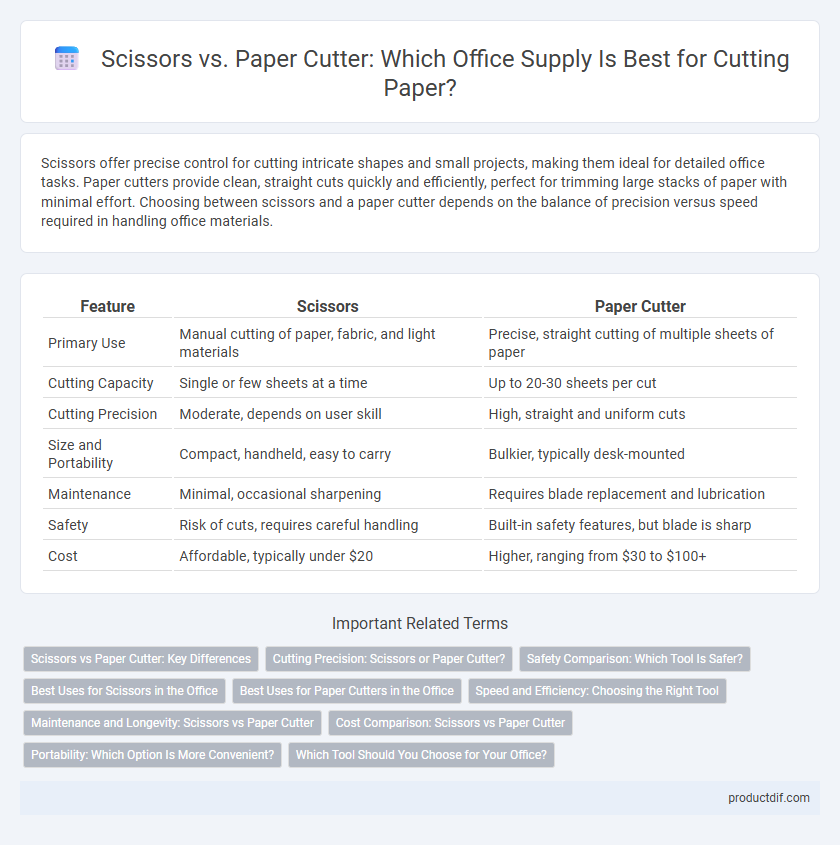Scissors offer precise control for cutting intricate shapes and small projects, making them ideal for detailed office tasks. Paper cutters provide clean, straight cuts quickly and efficiently, perfect for trimming large stacks of paper with minimal effort. Choosing between scissors and a paper cutter depends on the balance of precision versus speed required in handling office materials.
Table of Comparison
| Feature | Scissors | Paper Cutter |
|---|---|---|
| Primary Use | Manual cutting of paper, fabric, and light materials | Precise, straight cutting of multiple sheets of paper |
| Cutting Capacity | Single or few sheets at a time | Up to 20-30 sheets per cut |
| Cutting Precision | Moderate, depends on user skill | High, straight and uniform cuts |
| Size and Portability | Compact, handheld, easy to carry | Bulkier, typically desk-mounted |
| Maintenance | Minimal, occasional sharpening | Requires blade replacement and lubrication |
| Safety | Risk of cuts, requires careful handling | Built-in safety features, but blade is sharp |
| Cost | Affordable, typically under $20 | Higher, ranging from $30 to $100+ |
Scissors vs Paper Cutter: Key Differences
Scissors feature two pivoted blades ideal for detailed cutting and flexibility in handling various paper sizes and shapes, making them suitable for small tasks and precise cuts. Paper cutters, equipped with a fixed blade and a flat surface, offer straight, clean, and uniform cuts especially for larger stacks of paper, enhancing efficiency and accuracy. The choice between scissors and paper cutters depends on the volume and precision required, with scissors optimized for versatility and paper cutters designed for high-volume, consistent cutting.
Cutting Precision: Scissors or Paper Cutter?
Paper cutters deliver superior cutting precision for office tasks requiring straight, clean edges, especially with multiple sheets at once. Scissors offer greater control for intricate or curved cuts but may result in uneven edges when handling thick or stacked paper. For consistently accurate straight cuts, paper cutters outperform scissors in cutting precision and efficiency.
Safety Comparison: Which Tool Is Safer?
Scissors offer greater control and precision for detailed cutting tasks, reducing accidental slips, while paper cutters, with their exposed blades and heavier mechanisms, pose a higher risk of injury if not properly handled or maintained. Safety features such as blade guards and ergonomic handles on scissors enhance user protection, whereas paper cutters require strict adherence to safety protocols to prevent severe cuts. Choosing scissors over a paper cutter is generally safer in environments with frequent, small-scale cutting due to their manageable size and safer blade exposure.
Best Uses for Scissors in the Office
Scissors in the office are best suited for precise cutting tasks such as trimming documents, opening packages, and crafting presentations. They offer versatility in handling various materials like paper, cardboard, and lightweight plastics with ease. Their ergonomic design enables comfortable use for detailed cutting jobs that require accuracy and control.
Best Uses for Paper Cutters in the Office
Paper cutters are ideal for producing precise, clean cuts on large stacks of paper, making them essential for preparing brochures, business cards, and reports in office settings. Their sharp, sturdy blades and stable cutting base ensure efficiency and accuracy, reducing manual effort compared to scissors. Choosing a paper cutter enhances productivity and maintains professionalism by delivering consistently neat edges on various office documents.
Speed and Efficiency: Choosing the Right Tool
Scissors offer flexibility for cutting various shapes and materials but require more manual effort and time for large volumes. Paper cutters deliver precise, straight cuts rapidly, making them ideal for high-volume tasks and improving overall efficiency. Selecting the right tool depends on balancing the need for speed with the type and quantity of material being processed.
Maintenance and Longevity: Scissors vs Paper Cutter
Scissors require regular sharpening and careful cleaning to maintain their cutting precision, as dull blades can affect performance and shorten lifespan. Paper cutters often demand less frequent maintenance, but their cutting blades must be lubricated and occasionally replaced to ensure accuracy and durability. Proper upkeep significantly extends the longevity of both tools, maximizing efficiency in office supply usage.
Cost Comparison: Scissors vs Paper Cutter
Scissors typically cost between $5 and $20, making them a budget-friendly option for everyday office tasks. Paper cutters range from $20 to $100 or more, depending on size and features, offering greater precision for cutting multiple sheets efficiently. Choosing between them depends on balancing initial investment with task frequency and required cutting accuracy.
Portability: Which Option Is More Convenient?
Scissors offer greater portability due to their compact size and lightweight design, making them easy to carry in a pencil case or small bag. Paper cutters, while providing precise and efficient cutting for larger volumes, are bulkier and less convenient to transport. For users prioritizing mobility, scissors are the more convenient choice compared to the stationary nature of paper cutters.
Which Tool Should You Choose for Your Office?
Scissors offer precise cutting and versatility for small tasks such as trimming paper or opening packages, making them essential for everyday office use. Paper cutters provide clean, straight edges and handle large stacks of paper efficiently, ideal for high-volume document preparation. Choosing between scissors and a paper cutter depends on the frequency and scale of cutting needs in your office environment.
Scissors vs Paper Cutter Infographic

 productdif.com
productdif.com